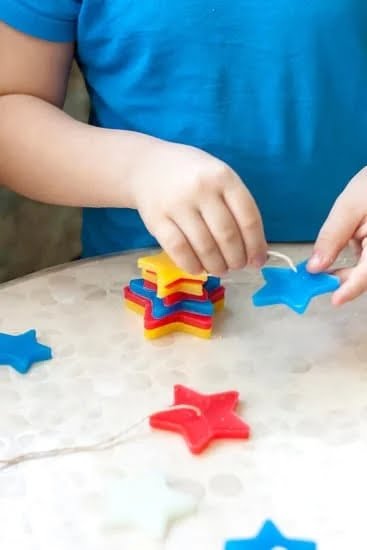Introduction
Candle-making is an ancient craft that dates back to 5,000 BCE in China, and later adapted and popularized by Ancient Romans. The art of candle-making has evolved over centuries and has been used for multiple purposes such as providing light during dark hours or ceremonial events. A unique process of candle-making involves using crushed ice to mold the desired shape and texture.
Crushed ice can be used to give candles a textured effect that adds visual depth. This technique is often used to produce designs like stars, waves, or stripes in the candle’s exterior. Additionally, inserting pieces of colored glass, shell fragments, or other interesting objects into the melted wax prior to freezing produces colors that are independent from colorants used in wax-only candles. Crushed ice not only plays a part in providing design elements but also helps the wax keep its shape during cooling as well as giving longevity to the finished product.
Tools and Materials Needed
Tools:
melting pot- for melting the wax;
wicks- choose a candle wick that is proportional to the height of your container & can hold the weight of the melted wax;
scissors- to cut off extra length from the ends of your wick;
matches- to light the candles.
Materials:
beeswax- used as fuel for the candle flame;
coconut oil- used to provide moisture to the beeswax and make it easier to pour;
chopped crayons or wax chips- used as colorants for your candles (optional);
crushed ice – placed inside each container before pouring in the melted wax, allows for deeper etching of design work.
Preparing the Wax
1. Measure out the appropriate amount of wax based on the size and number of candles you are making. This can be done by weighing the wax or by measuring it with a measuring cup.
2. Place the measured wax into a heat-safe glass or metal bowl and put it in a pan of water on medium-high heat. Stir with a wooden spoon as the wax melts until it is completely melted, about 15 minutes.
3. Take the bowl out of the pan and allow the wax to cool for 2-5 minutes until it reaches around 125 °F (52°C). Make sure not to leave it in water as that could change its temperature too rapidly, so use oven mitts when handling it if necessary.
4. Once at the desired temperature, add colorant if desired and stir to fully incorporate it before proceeding with scenting. The amount of colorant required depends on how intense you want your candles’ colors to look, but you should only need a few drops to get started.
5. Use fragrant essential oils or premixed scents for candlemaking for best results and carefully add little by little, stirring each time until you have reached your desired scent strength – remembering that temperatures below 65°F (18°C) cause scent molecules to become dormant, so judge fragrance strength relative to this temperature during testing!
6. Finally, using a funnel pour cooled scented & colored wax into your jars; be careful not spill as hot wax can cause burns & splattering! Keep an eye on temperatures throughout: Stop pouring when the thermometer reads 130-140 °F (54-60°C) before adding crushed ice – this will help ensure safe handling later& yield more even results while cooling down quickly enough so your mold can set properly!
Forming the Candles
1. Dab a small amount of the wax around the wick end before inserting it into the container. This will help the wick stay in place and secure.
2. Wrap the top of the wick around a pencil or skewer and lay it across the top of your container before adding wax. This will help ensure that your wick is centered while pouring in your wax.
3. Hold down the wicks with weights or something similar, such as paperclips, after pouring in wax so they don’t move around while it hardens.
4. Double check to make sure your wicks are secure before adding your crushed ice and letting candles set overnight – test by gently tugging on them to ensure they’re not loose or coming out!
Finishing Touches
There are endless possibilities of colors and aromas that one can achieve with crushing different types of ice and adding various scents. One of the most popular colors achieved is clear or transparent-looking if you crush regular ice cubes. This can be achieved by using a food processor or blender to grind the ice into small pieces. If your desired outlook is more colorful, there are molds that can be filled with fresh fruits, herbs, and spices like rosemary and basil. These molds create beautiful art, from hues of purples to blues and greens. To bring an extra element of scent to these candles, essential oils can be added for fragrance of minty flowers, citrusy oranges and lemons, sweet vanilla beans and more! Taking it a step further, powdered beads like glitter and micas adds shimmering brilliance when light shines through the candles as well as reflects off the surface.
Final Notes and Tips
Safety Considerations: When making candles with crushed ice, be sure to use caution. Hot wax can cause severe burns if exposed to skin. Place a spoon in the wax pot when melting the wax so that it does not splash onto you or anyone else in the vicinity. Be sure to use oven mitts or other heat resistant tools when removing hot wax from the pot and pouring into forms or other vessels.
How to Store Your Finished Candle: After your candle has cooled, store it in a cool dry place away from direct sunlight. This will help your candle last longer and burn better when lit. If storing multiple candles, note that the larger ones may take up more space, so consider how much storage space you have available before selecting your form size. Avoid overcrowding candles close together when storing as this could increase chances of melting and damage to each candle’s shape.
Conclusion
Making candles with crushed ice is an easy and fun activity to do with friends, family or by yourself. We had a lot of fun playing around with wax, colors and scents while making these unique candles. If you decide to replicate this project, feel free to experiment with the size of your containers, melting temperatures and choice of wick – it can open up exciting possibilities!
We invite readers who have tried out this project to share their experiences in the comments below – we would love to hear about what worked for you and what didn’t. At the same time, why not consider sharing a picture of your finished work? We will compile them into a gallery where everyone can access each other’s creations!

Welcome to my candle making blog! In this blog, I will be sharing my tips and tricks for making candles. I will also be sharing some of my favorite recipes.





